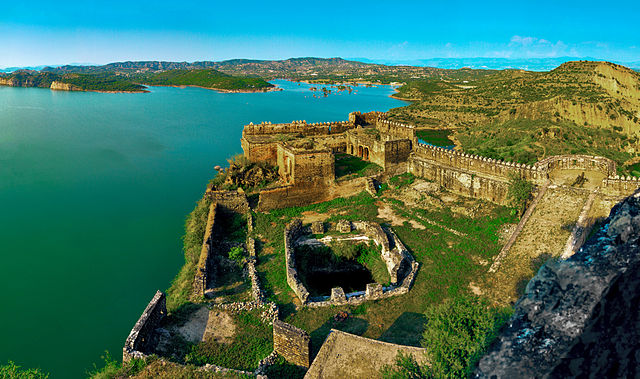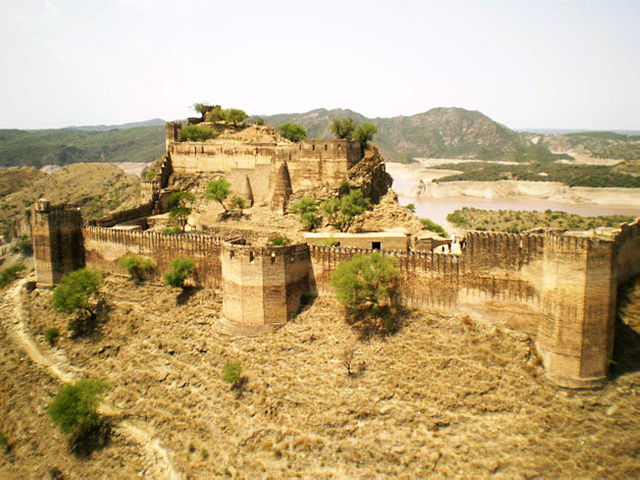The ruins of the small and picturesque Ramkot Fort are nestled on the top of a hill surrounded on three sides by the blue waters of the man-made Mangla (Dam) Lake.
The lake is approximately 12.5 miles from the hamlet of Mangla and is on the opposite side to New Mirpur City in the self-governing administrative territory of Azad Kashmir, Pakistan. Technically, it is on the confluence of the rivers Jhelum (called “Vitasta” in ancient times) and Poonch.
Scroll down for footage
The fort provides an excellent insight into the rich past of the region but also offers magnificent views of the surrounding hills and Mangla Lake, which was built across the Jhelum River in 1967.

Aside from its breathtaking scenic beauty, the site of the fort is of significant architectural and archaeological value. Systematic archaeological excavations have revealed that the fortification was erected over the site of a Hindu temple dedicated to Shiva. Near the remains of one of the ancient temples, relics were found that are thought to be from between the 5th and 9th centuries.

The fort is located on the historic border between Kashmir and Pakistan. Between the 16th and 17th centuries, the Muslim rulers of Kashmir constructed numerous forts in order to defend their territory. It is believed that Ramkort Fort was erected during this period as part of the same defensive project.
This defensive complex is a perfect example of Muslim military architecture.
Ramkot Fort has identical architectural characteristics to the Mangla and Muzaffarabad Forts, but it also has some unique features that make it one of the most famous landmarks in Azad Kashmir.
There are not many known historical documents about it; however, the traveler and geologist Frederic Drew in his work from 1875, The Jummo and Kashmir territories: A Geographical Account, wrote that the fort was built by a Gakkhar named Toglu. After the Gakkhars, it was controlled by the Dogras.

In the 19th century, the Dogra Maharaja of Kashmir ordered for additional reinforcement of the complex. Numerous ingenious details were implemented in order to provide better defense.
Now, visitors can see that the interior was specially designed to be filled with various war mechanisms. The ramps that go from the ground floor level to the parapet served to bring the cannons and artillery into their positions for action. The complex has only one entrance and it is obvious that this was for strategic reasons.
The water tanks are an interesting aspect of the site. Historians still do not know why such a relativity small fort had such large tanks.

In the past, the location of the site was probably considered to be extremely strategic; but since the construction of the dam, it became isolated. The tough terrain and its inaccessibility led this ancient fort to be forgotten and to fall into ruin. Even today, it is not as popular as other tourist spots around the lake.

During the construction of Mangla Dam and the creation of Mangla Lake, the fort was heavily damaged. Great parts of the complex were reduced to ruins and overtaken by vegetation and piles of mud.
The site remained quite unknown and neglected until the end of the 1990s when a dentist from the city of Rawalpindi accidentally came into contact with this forgotten treasure while fishing.

He decided to spend a lot of money on its restoration. The site was cleaned and refreshed by volunteers, architects, and archaeologists and was brought back in life in less than a year. A few old cannons donated by the Pakistan Army were placed as an attraction.
But, before long, action on the site ceased. It seems that without support and real action from the local authorities, the site could not be popularized and saved from vanishing. In the last decade, due to lack of proper care, the cannons have broken down and some of the surviving parts have collapsed. Unfortunately, some of the surviving roofs of the structures are still unstable and in danger of collapsing.

But the fort still has retained a lot of its former greatness and certainly has a lot to say. It is open for public visits and can be approached by boat from the water sports club at Mangla Dam.

The boat trip ends on the northern side of the lake and lasts 10 to 20 minutes. From July to September (when the water of the lake is on its highest level), one can climb from the foot of the cliff to the top. The climb is short but rough, with approximately 350 stairs. The walk is much longer in the drier months of the year.
